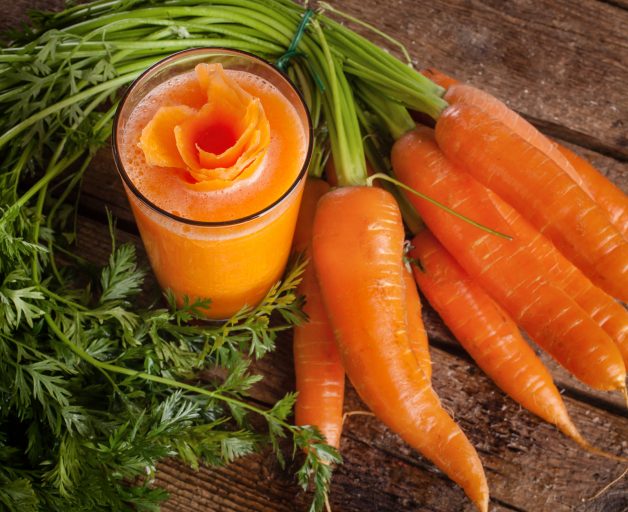Did you know that ancient Romans and Greeks ate carrots, but not the orange varieties we know today? They ate wild varieties of various other colors, such as purple, red, white, and yellow.

In the 17th century, orange carrots as we know them, first appeared in the Netherlands. Dutch farmers invented the orange carrot in honor of the “House of Orange”, the Dutch Royal Family. The orange color results from beta-carotene, which is a red-orange pigment found in some plants and fruits.
Carrots contain quite the nutritious punch. The most widely known health benefit of carrots is that they contribute to good vision. This is because our bodies turn beta-carotene into vitamin A, which is important for the health of vision (including night vision), and carrots are one of the best sources for beta-carotene. The vitamin A is also important to the health of our bones, skin, and teeth.
Carrots are known to have many medicinal properties. Eating carrots can aid the body in repairing damaged cells. They also can be used as an antiseptic for skin wounds, and very effectively clean your mouth from bacteria.
Other little-known facts about carrots include:
- Just a handful of baby carrots or one medium carrot counts as one serving of your daily veggies.
- Carrots are a good source of fiber, which means they are good for the digestive system.
- Vitamin C, potassium, folate, and vitamin B6 are also found in carrots, as well as several minerals like magnesium and calcium.
- The purple pigments of the purple carrots are called anthocyanins. Anthocyanins act as anti-oxidants that protect the body.
- Including carrots in your diet when breast feeding helps to improve breast milk production.
- A carrot is 87% water, so consuming them can help you to be sure your body is getting an adequate amount of H2O.
- Out of all vegetables, it’s no surprise that carrots have the largest content of vitamin A (beta carotene). 100 grams of carrot will give you 104% of the recommended daily dose.
- 30% of American Vitamin A intake comes from carrots.
- One glass of milk contains the same amount of calcium as in 9 carrots.
- One carrot gives you the energy to walk one mile!
As you can see it is very beneficial to make sure carrots are a part of our diets. However, it is true that eating massive amounts of carrots can sometimes cause a person’s skin to turn yellowish orange. This is a condition called carotenemia and is most noticeable on the soles of your feet or the palms of your hands. It requires an extremely high amount of carrot consumption to get carotenemia, so it is not very common, and it is completely reversible by just reducing carrot intake.
Carrots can be eaten in various different ways. You can eat them raw, they are delicious dipped in hummus or ranch. Carrots are often boiled, baked, fried, grated, juiced, mashed, pulped, pureed, and steamed. Carrots are also often used in stir-fries and salads. They can also be dehydrated to make chips, powder, and flakes. Even the carrots greens are edible, but consumption is rare.
In western countries, the natural sweetness and sugars of carrots allow them to be used in decadent desserts like carrot cake. Portugal is known to use carrots in jam, and in India they are used in many deserts. Around the world carrot juice is widely consumed, especially as a health drink, with or without other fruits and vegetables. You can try them in one of the several recipes that we have collected here on FillYourPlate.org.
In 2004, carrots were ranked as the seventh most valuable crop grown in the United States. California is our top fresh carrot producer, and Washington is the top grower of carrots meant for canning and processing. However, Arizona carrot production is nothing to sneeze at. The Rousseau Family Farms is our largest carrot farmer producing on average 42,000,000 pounds of carrots each year which are then sold to grocers all over the United States (including Arizona). The average American eats around 10.6 lbs. of fresh carrots a year, so the carrots grown at Rousseau Family Farms alone can feed around 3,962,264 people in a year!
There really are quite a bit of carrot facts. Here are some more!
- Mel Blanc (the voice of Bugs Bunny) was allergic to carrots!
- Baby carrots aren’t actually babies. A baby carrot comes from a large carrot that was rolled over blades and thrown around in a metal cage to be rubbed down into a round-ended, short baby carrot.
- Out of all of the vegetables, only the beet contains more natural sugars than carrots.
- One teaspoon can hold 2000 carrot seeds.
- In 17th century England, carrot leaves were often carried in the hair as a fashion statement.
- Carrots were first introduced to America in 1607 with the first settlers who landed in Jamestown, however they did not become a very popular food until soldiers returned from WWI after having constant contact with them.
- Wild rabbits don’t eat wild carrots.
- The heaviest carrot recorded weighed 18.985 lbs.
- The longest carrot recorded was nearly 17 feet long.
Rousseau Family Farms, though our largest carrot producer, is not the only place you can go to enjoy locally grown carrots. When you visit Fill Your Plate, you can click on “Find a Farm Product” and type in carrots, and a list of local growers will pop up. You can then choose a grower closest to you. You can also buy fresh Arizona-grown carrots from Rousseau Family Farms, most likely, at your local grocery store.
Related articles
- Fun Facts About Zucchini (fillyourplate.org)
- A Simple Guide to Start Eating Healthier (fillyourplate.org)
- Fun Facts about Clementines (fillyourplate.org)

